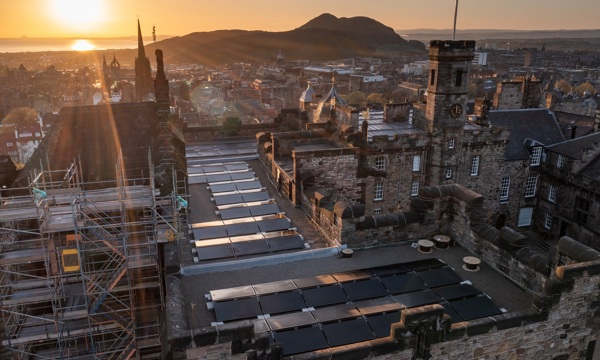The solar panels have been installed on the roof of the Scottish National War Memorial, with the works funded by Scottish Enterprise. Due to the War Memorial’s elevated and open location at the summit of Castle rock, as well as its surrounding high parapet, the panels are not visible from any other vantage point within the site, city or surrounding areas.
The installation design has also sensitively taken into account both the cultural significance of the monument and its historic fabric. Prior to commencing the works, HES engaged with range of stakeholders as part of the planning process, including working closely with the trustees who manage the building.
The renewable energy generated by the new solar panels is projected to reach approximately 26,500 kWh per year, equivalent to around 6,680kg of CO2. It is expected that this will more than offset the electrical consumption of the War Memorial building, with any additional energy generated being used elsewhere within the site. This will help further the significant carbon reduction efforts at Edinburgh Castle in recent years, which have achieved a 29% reduction in energy consumption and 46% decrease in associated carbon emissions at the site before the Covid pandemic.

As outlined in its Climate Action Plan, HES is committed to becoming net-zero by 2045 - in line with Scottish Government targets - by halving its annual emissions over the next ten years and beyond.
David Mitchell, Director of Conservation at HES, said:
“As a major player under the 2009 Climate Change Act, we have a responsibility to lead by example in reducing our carbon emissions, and in developing innovative approaches to promote sustainability.
The installation of solar panels at one of Scotland’s most iconic historic sites is another step forward in our efforts to significantly reduce the carbon we generate across our estate. Edinburgh Castle accounts for 26% of our total carbon emissions and 18% of total electrical consumption across the properties in our care, making it critical that we investigate ways to reduce this.
“It was crucial that the design plans took into careful consideration the historic, cultural and emotional significance of the War Memorial, involving close collaboration with the trustees. The final plans for the installation of these panels have been sensitively designed to consider the historic fabric of the building and the wider views of the War Memorial and Edinburgh Castle itself within the city and surrounding areas.
“By pioneering schemes such as this, we can demonstrate that historic buildings are part of the solution to reducing emissions and helping Scotland reach net-zero.”
Find out how we're tackling the climate emergencyAbout Historic Environment Scotland (HES)
- We are the lead public body charged with caring for, protecting and promoting the historic environment. We will lead on delivering Scotland’s first strategy for the historic environment, Our Place in Time.
- Historic Scotland, Scran, Canmore, The National Collection of Aerial Photography (NCAP), The Engine Shed, Stirling Castle and Edinburgh Castle are sub-brands of HES.
- View our press pack and keep up to date by registering for media release email alerts. If you wish to unsubscribe, please contact us.
Twitter: @HistEnvScot | @welovehistory
Facebook: @HistoricEnvScotland | @VisitHistoricScotland
Instagram: @HistEnvScot | @historicscotland
For further information, please contact:
Claire Mullaney
Historic Environment Scotland Media Office
Mobile: 07221 959 962
communications@hes.scot

